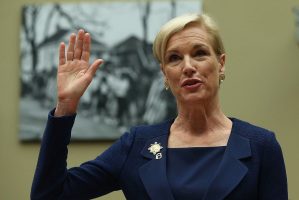Markets show unelected Fed matters more than elected Congress
Last week, we saw unexpected election results with Republicans falling short of expectations in the congressional elections. Markets responded to that shift in expectations by signaling lower growth. In other words, investors, those with skin in the game registered the idea that whatever the problems with the Republicans, they are more likely to promote growth and control inflation.
However, later in the week, inflation data was released and it was lower than expected and markets strongly reversed course. In other words, looking at the order of magnitude of the market responses, one can conclude that those who are most strongly incentivized to face economic reality act as though the direction of the non-elected members of the Fed is more important than the direction of the elected Congress. That's how much power the central bank has accumulated.
The progressive ideology which led to the creation of powerful institutions ruled by the academically trained and selected expert class has made an institution isolated from citizens the most powerful financial entity in the world. This is deeply at odds with a Biblical world-view which is skeptical about the ability of intellectual expertise to overcome the flaws in human nature. The Bible doesn't trust people with power, and Ivy-league credentialing is no exemption from that distrust. Both elite and populist classes can fail to lead properly, but at least with processes requiring the consent of the governed, there is the possibility of change. Recent data showed us how far we've gotten from that.
Big Picture: Market watchers might have believed that the unexpectedly weak Republican performance in last week's election would be the big news of the week when it comes to moving markets. If they did, the data proved them wrong. Markets did initially react to the lack of a 'Red Wave', and they reacted in predictable ways. Stock markets sold off, with growth sensitive stocks selling off more than recession hedges and other defensive stocks. Investors moved from stocks to bonds. Gold rose and the dollar fell. Global markets outperformed US markets.
In short, investors concluded that a red wave would likely have been better for growth and better for the spending controls which might help temper inflation. When the wave failed to appear markets rendered their verdict in the form of anti-growth trades.
But then the real big news of the week came out, the inflation data. It showed a drop in inflation. More importantly inflation was lower than markets expected. This, of course, created an excuse for the Fed to ease up on painful monetary contraction. It gave ammo to the newly emergent 'dove' faction. Remember 'dove' refers to policy advocates who favor the mandate to keep labor markets strong than to the mandate to keep inflation low. The standard package of dovish sentiment shifts showed up in markets:
- Gold rose.
- The dollar fell.
- Futures markets signaled smaller Fed hikes in the future.
- Futures markets indicated that the Fed would reverse course and start cutting earlier, i.e. in June.
- Bond yields fell.
- Most stock markets rose, easily outperforming bonds
- Copper which is widely seen as a growth-sensitive commodity (nicknamed Dr. Copper because it's such a good economic forecaster) rose substantially.
- REITS rose, performing better than stocks and most bonds.
In short, after the inflation numbers, the anti-growth trades which had come in the first half of the week in response to the election results, reversed themselves and became pro-growth trades. Interestingly looking at the whole week, we see pro-growth trades, which means that on balance, the markets' reactions to the inflation report was big enough to overcome and reverse its reaction to the election news. Since the election was seen as Fed-neutral (and indeed the election results barely moved the needle on Fed Funds futures) This is consistent with the idea that markets treated the Fed as more important than the election.
Bonds Last Week: Bond markets were generally up last week, which fits the narrative of the week - the Fed will create new money and buy more bonds sooner, and sell fewer bonds in the short-term.
But the real story is found by comparing different types of bonds, at individual sectors. The story was consistent with the higher growth outlook, with high yield bonds and investment-grade corporate bonds significantly overperforming treasuries.
The growth risk thesis is simple: when business slows down, companies find it harder to make their debt payments. So lower-credit-quality bonds are more likely to default and forward-looking investors sell them now rather than risk being left holding the bag if a company defaults on its debt service payments. That works both ways, higher growth rates help those companies make their debt service payments.
Real Estate Last Week: REITS performed positively, which one would expect given the prevailing themes of the week: falling rates, rising inflation risks and improving growth outlook. REITS do well with inflation (real estate is an inflation hedge), somewhat well with growth (because in seasons of higher growth renters can afford to pay more, but on the other hand long-term leases can act as a hedge against recession); and low interest rates (because it is a debt-dependent sector). Last week's trading pattern implied that all three of those pro-REIT conditions were more likely to occur than previously thought.
U.S. Stock Markets Last Week: Domestic equity markets were generally up last week, with growth stocks significantly overperforming value stocks. That overperformance occurred among large, mid and small size company categories. Growth tends to beat value when growth expectations are rising, because low growth presumably makes it easier for earnings to actually deliver on growth companies' high expectations. So, the strong growth performance is consistent with the other pro-growth trades of the week.
Also, growth stocks are more dependent on low interest rates than value stocks, so consequently they also tend to underperform value stocks when interest rate expectations are rising, because their long time horizon causes the discounting effect of interest rates to play out over a longer period of expected future earnings. That works both ways, meaning lower rate expectations tend to help growth stocks relative to value stocks. Last week, the consensus of markets signaled lower interest rates than previously expected, which is both theoretically and historically good for growth stocks. Accordingly, growth beat value.
The difference in performance between different stock sectors: S&P/NASDAQ, cyclical/defensive, discretionary/staples, discretionary/utilities, etc., also showed a more optimistic growth shift.
So, the lower future rates picture was fairly clear in the domestic stock market data, and so was a slightly softer landing picture.
International Stock Markets Last Week: International equity markets were generally up for the week, but not of the same order of magnitude. In general U.S. beat global stock markets in price returns. This occurred in spite of a falling dollar. In other words, foreign markets generally performed worse than U.S. markets even though their currencies generally performed better than the dollar. This all suggests markets might be edging slightly back to the idea of the U.S. as a refuge from the global recession.
In addition, EM was marginally positive but significantly lagged DM.
Jerry Bowyer is financial economist, president of Bowyer Research, and author of “The Maker Versus the Takers: What Jesus Really Said About Social Justice and Economics.”





























